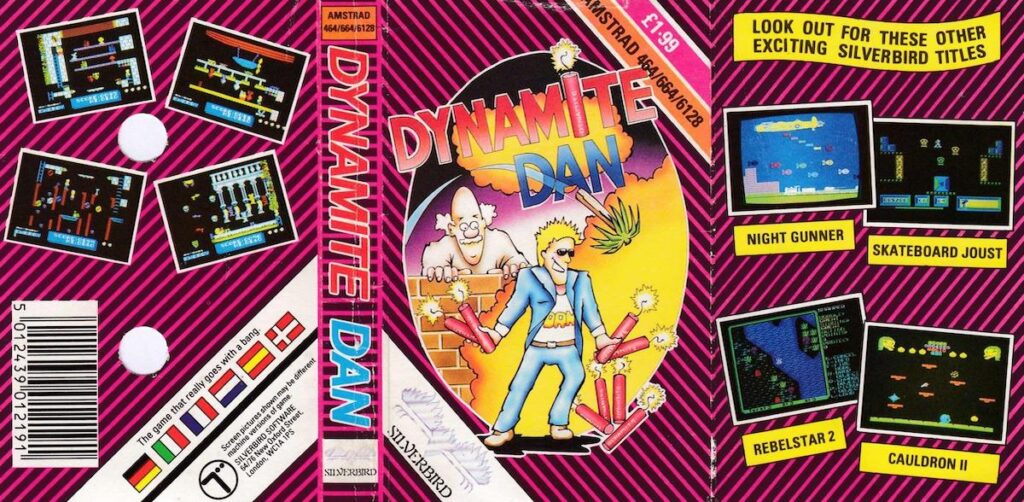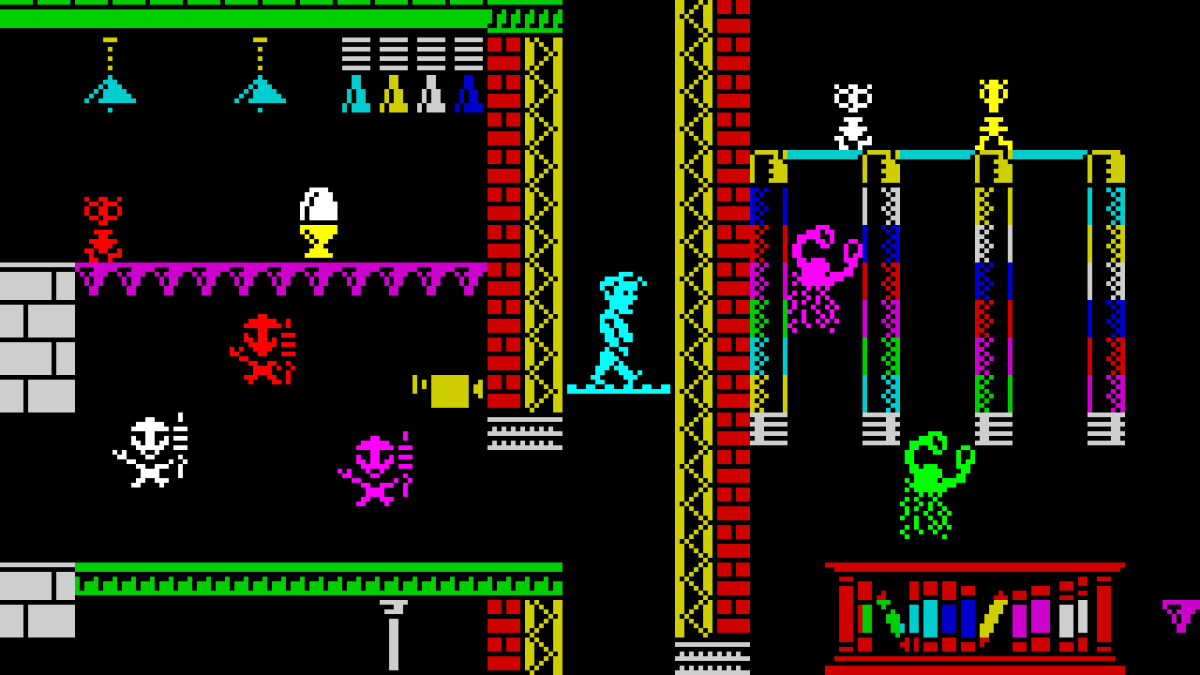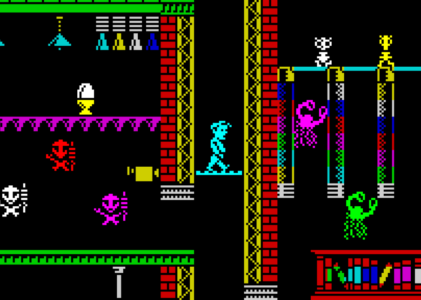In the annals of video game history, there exist certain titles that hold a special place in the hearts of gamers, classics that define an era and lay the foundation for future gaming innovations. One such game is “Dynamite Dan,” released in 1985. In this article, we’ll delve into the world of Dynamite Dan, exploring its genre, platforms, gameplay, key features, strategies, reviews, cultural impact, sequels, and similar games that continue to captivate gamers even today.
The Explosive Genesis of Dynamite Dan
Genre: Action, Platformer
Platforms: ZX Spectrum, Amstrad CPC, Commodore 64
Before we dive into the gameplay and intricate details, let’s set the stage by understanding what Dynamite Dan was all about. Developed by the legendary Spectrum software house, Rod Bowkett and David Jones created this iconic game for various platforms like ZX Spectrum, Amstrad CPC, and Commodore 64.

Gameplay: Navigating the Explosive Labyrinths
Dynamite Dan presented players with a unique blend of action and platforming, setting the stage for an exhilarating adventure. Players took on the role of the titular character, Dynamite Dan, an intrepid explorer on a mission to collect treasure while navigating treacherous underground labyrinths.
The game’s levels were filled with deadly obstacles, from menacing monsters to challenging puzzles, all of which Dynamite Dan had to overcome using his wits and explosives. The objective was simple but engaging: collect all the gems within a level while evading enemies and strategically using dynamite to clear obstacles.
Key Gameplay Features: A Blast from the Past
- Explosive Arsenal: Dynamite Dan’s primary tool was, unsurprisingly, dynamite. Players had to use it wisely to destroy barriers, clear paths, and eliminate enemies strategically. This mechanic added a layer of strategy to the gameplay.
- Puzzle Elements: Beyond mere platforming and action, the game incorporated puzzle elements. Players needed to solve intricate puzzles to progress through certain levels, adding depth and variety to the experience.
- Time Pressure: Each level had a time limit, which added an extra layer of challenge. This required players to think on their feet, making quick decisions about where and when to use their dynamite.
- Varied Environments: Dynamite Dan offered diverse environments, from underground caverns to ancient temples. Each setting brought its own unique challenges and visuals, keeping players engaged throughout the game.
- Hidden Secrets: Like any good adventure game, Dynamite Dan was filled with hidden secrets and treasures, rewarding players who explored every nook and cranny.
Strategies and Cheats: Navigating the Explosive Challenges
Mastering Dynamite Dan required a combination of quick reflexes, problem-solving skills, and a knack for strategizing. Here are some tips and strategies to conquer the game:
- Plan Your Explosions: Don’t waste dynamite. Plan your explosions carefully to clear obstacles efficiently, especially when dealing with limited resources.
- Study the Patterns: Each level had its own set of challenges and enemy patterns. Observe these patterns and plan your movements accordingly.
- Timing is Key: With a time limit on each level, timing is crucial. Don’t rush blindly; take a moment to assess the situation before making your move.
- Collect Everything: To maximize your score and chances of success, aim to collect every gem and uncover all the hidden secrets in each level.
- Practice, Practice, Practice: Like many classic games, Dynamite Dan’s difficulty level increased as you progressed. Practice is essential to mastering the game’s intricacies.

Reviews and Cultural Impact: A Dynamite Reception
“Dynamite Dan” received critical acclaim upon its release. The combination of action, puzzles, and strategic gameplay made it an instant hit among gamers of the 1980s. It was praised for its engaging mechanics, challenging levels, and the sheer thrill of blowing things up with dynamite.
Cultural impact-wise, Dynamite Dan played a pivotal role in shaping the early gaming landscape. It contributed to the popularity of platformer games during that era and inspired many subsequent titles. Its legacy is visible in the platformer genre’s growth and evolution over the years.
Sequels and the Legacy of Dynamite Dan
The success of Dynamite Dan naturally led to the development of sequels. The most notable follow-up was “Dynamite Dan II: Dr. Blitzen and the Islands of Arcanum,” released in 1986. This sequel continued the adventures of Dynamite Dan and introduced new challenges, enemies, and environments.
While the Dynamite Dan series may not have reached the same level of recognition as some other gaming franchises, it remains a beloved classic among retro gaming enthusiasts. Its influence can be seen in modern indie games that draw inspiration from its gameplay mechanics and design principles.
Examples of Similar Games: Exploring the Platformer Genre
If you enjoyed Dynamite Dan and are looking for similar gaming experiences, here are a few titles from the same era and beyond that capture the essence of classic platformers:
- Manic Miner (1983): Another iconic ZX Spectrum game, Manic Miner shares similarities with Dynamite Dan in terms of platforming and puzzle-solving within an underground setting.
- Jet Set Willy (1984): Created by the same developer as Manic Miner, Jet Set Willy is a platformer known for its challenging gameplay and intricate level design.
- Spelunky (2008): This modern indie title draws inspiration from classic platformers like Dynamite Dan. It features procedurally generated levels, challenging gameplay, and a strong emphasis on exploration.
- Cave Story (2004): A critically acclaimed indie game, Cave Story offers a blend of action, platforming, and exploration reminiscent of classic platformers.
- Shovel Knight (2014): Shovel Knight combines retro aesthetics with modern gameplay mechanics, making it a perfect choice for fans of classic platformers like Dynamite Dan.
In conclusion, Dynamite Dan (1985) is a timeless classic that left an indelible mark on the world of gaming. Its unique blend of action, platforming, and puzzle-solving, coupled with its engaging gameplay and strategic depth, continues to captivate gamers even in the modern era. While it may not be as widely recognized as some other gaming franchises, Dynamite Dan’s legacy lives on in the hearts of retro gaming enthusiasts and in the design of contemporary indie games that pay homage to its explosive charm.

